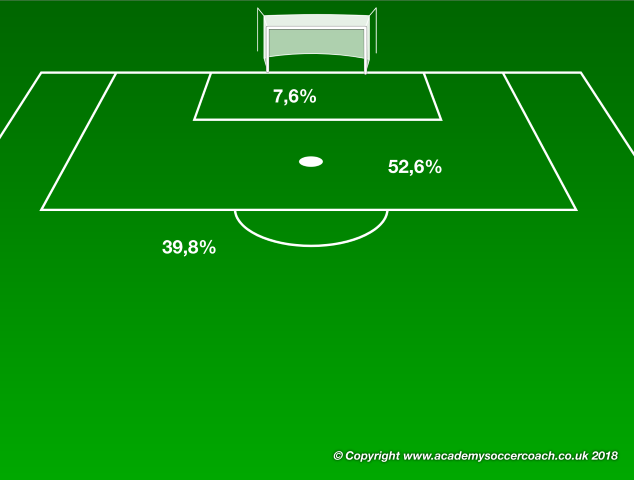WORLD CLASS COACHING
40 Shooting and Finishing Exercises
By Luca Bertolini
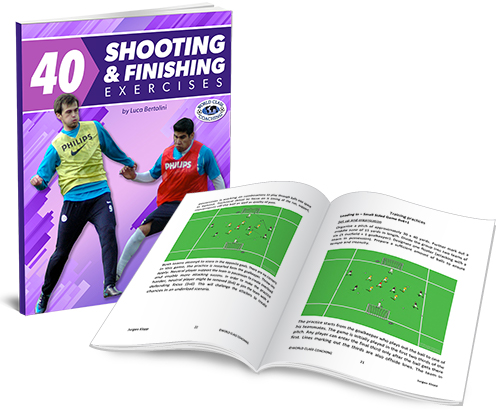
Table of Contents
PART ONE
Introduction
How to Organize Shooting and Finishing Exercises
PART TWO
Shooting and Finishing Exercises With and Without Opposition Pressure
PART THREE
Shooting and Finishing Sequences
PART FOUR
Shooting and Battle Exercises
Introduction - how to organize shooting and finishing exercises
Last 2017/2018 Premier League Championship was a record season for Manchester City, the winner:
• Most wins in a season - 32 matches
• Most consecutive wins - 18 matches (26 August 2017 - 27 December 2017)
• Most points in a season - 100
• Biggest title-winning margin - 19 points
• Most goals scored in a season - 106
We are going to take this season as the main source for all the data and following considerations.
Let's now have a look to data to understand how goals were scored during the whole season and deeper, how Man City scored all these goals.
The main goal of this book is to create "40 shooting and finishing exercise" that can be considered really effective and to propose practices where the players can reproduce all the finishing situations that may occur during a football match and moreover inside the same spaces where the most of the goals are scored from.
As first data, here's the scored goals from outside the box ranking, which is based on the total goals scored for each team, of the last Premier League season...

...And these are those about the goals scored from inside the box

It's clear how these numbers affect our understanding of the finishing phases of Premier League teams.
These are the headers goals; they seem to be a solution for medium level teams rather than for the top class of the league. They are just the 11% of the scored goals for Manchester City, but the 27% for Chelsea, which finished sixth.

This means that headers must be coached, but not as first objective of the practices, if we are going to work with high or medium level players. The best way should be to consider them as variations of the shooting phase of the exercises.
Manchester City, the example we are using to develop finishing and shooting exercises, scored 88% of their goals from inside the box.

We ask these questions: How did they scored these goals and what kind of moves were carried out to finish? Let's take a look to some other data of 2017/2018 Premier League season.
These are the total passes of the whole season:
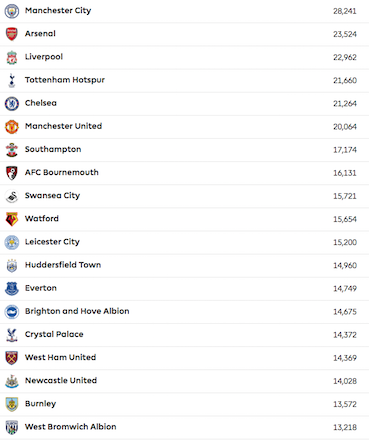
This means that Manchester City completed an average of 743 passes during each of the 38 matches of the season; the 19 point-margin runner-up Manchester United had an average of 528 passes for each match. Possession seems to be important to create concrete scoring chances.
If we look to the other teams’ passing averages, we notice the ranking placement and the margin from the winners:

We see that possession can be a good tool to create finishing chances, but it must be effective.
"We possess the ball not to just to move it, but to move the opposition," Guardiola is used to say, talking about possession.
On dribbling: "If you dribble to overcome an opponent is ok, but if it's not, move the ball to attack all together."
On back passes: "A back pass can create a forward space in behind the opposition lines." And it's so true looking at the back passes ranking and average.
Possession and creation of spaces by moving the opposition are two main key points to I have kept in mind when designing these exercises.
4.546 passes of the 28.241 of the last season were back passes--16%.

Manchester City is an attacking-oriented team, but back-passes make sense when thinking about moving the opposition, inviting the opposition pressure, to create space forward space behind the lines.
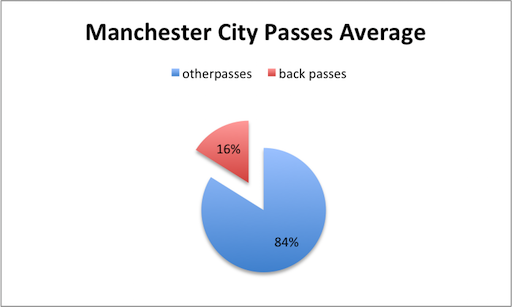
Let's now take a look at the finishing stage of the moves of Manchester City and try to understand how they took the move to the final stage last season.
These are the data of through balls--Manchester City leads this ranking together with Arsenal, which showed a similar style of play and Liverpool, which finishes this way many counter-attacks.
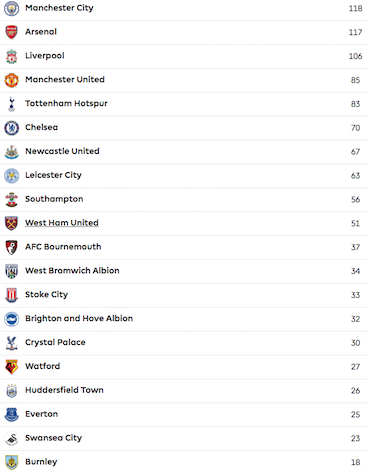
The average of through balls for each match of Manchester City is 3 passes; this poor data shows that possession oriented attacking team leads the opposition to defend deep, to avoid this kind of passes, when the move is being played inside the defense half.
Through balls are a good solution for a possession-oriented team if the opposition is not too deep inside the defending half. But Manchester City, just like Guardiola's Bayern Munich, is used to attacking through the wingers and finishing with runs by the advanced midfielders, attacking the opposition penalty area.
This finishing style is demonstrated by the offside ranking of Manchester City. Most of the blind runs come from the back as support instead of an attacker freeing himself from a marker along the opposition defense line. The latter is much more difficult because the timing has to be just right.
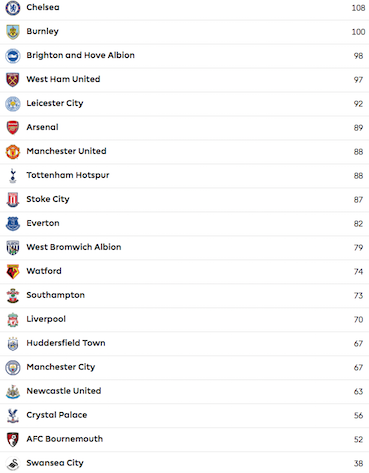
The offside average of Manchester City was 1.7 times during each match. It's clear how Guardiola's team attacked the depth from the back and against a deep defending opposition.
The leading team were in fact counter attacking or direct play oriented teams; Chelsea (2.8 off-sides each match), Burnley (2.6), Brighton and Hove Albion and West Ham (2.5).
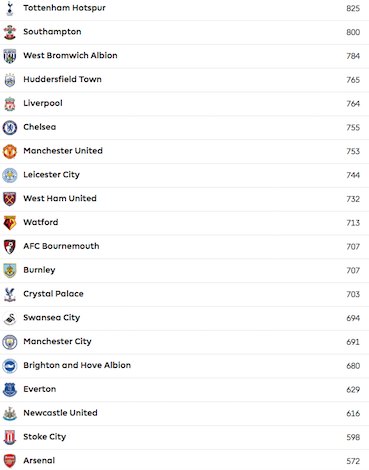
Despite being an attacking wingers-oriented team, Man City is not mainly a crossing team, as the wingers are used to move the opposition toward wide positions and to stretch the lines. Once they are in possession, they tend to look for 1 v 1 duels, dribble toward the opposition goal, or look for an incoming teammate.
The average for each match was 18 crosses, many of which were switches of play to free the opposite winger and they were played from the strong side that was created. What is very interesting is that Manchester City is the leader of 2017/2018 of the shots on goal and on target. These are the proof of the efficacy of the possession and attacking team phase and of the finishing skills of the forwards.

The average of City is 17.5 shots per match
c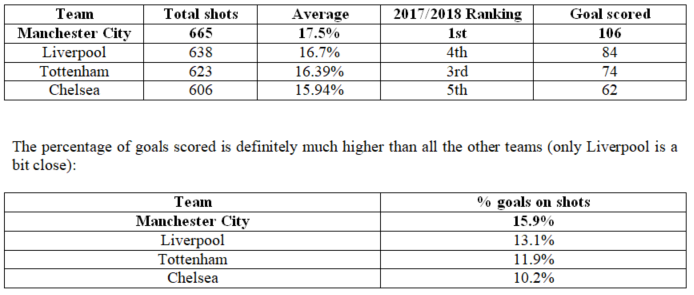
Again, Man City is the leader of the shots on target ranking.
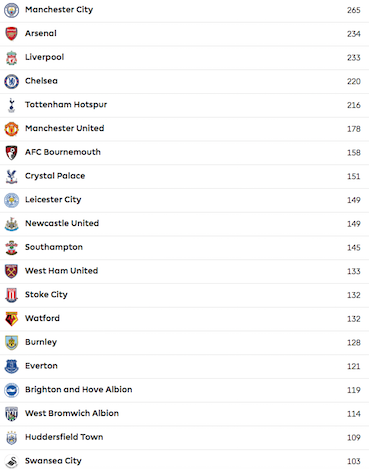
The average of City is 6.9 shots on target per match and the goal average is 40%; 9 points more than the second ranked team for shots. Only Manchester United was quite close for efficacy (38%).

"I am not a coach for the tackles so I don't train the tackles. What I want is to play good and score goals... What are tackles?"
Looking at some of the defense data of 2017/2018 season, Manchester City was placed among the relegated team or just a little above them.
This is the tackle season data, with an average of 14.8 tackles each of the 38 matches of the entire league.
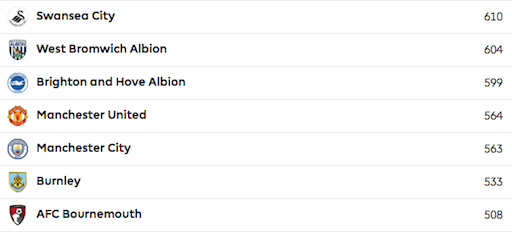
Here's the clearances data. A clearance is classified as a kick to counter an opponent, during the defense phase, without the purpose of a pass or of transition to attack. Man City is ranked last, with an average of 15.04 each match.
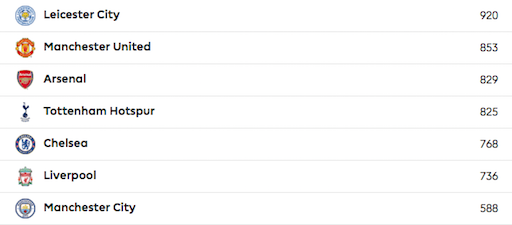
Looking at the interceptions data (Man City average is 9 per match), it's clear that the winners worked more against the opposition possession than on the closure of spaces and of passing lanes. Pressure is the main key factor to win the ball back.
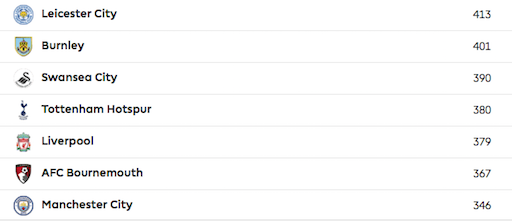
How do we design effective shooting and finishing exercises, thinking about the best Premier League team of last 2017/2018 season?
Manchester City had the best passing ranking, scored the most number of goals ever, had the best average of scored goals compared to shots and shots on target. But it was ranked lower positions from a defensive point of view.
From this we can see that there isn't a clear connection between the defensive technical gestures and tactical positioning and the efficacy of the finishing phase, if the transition phase is not properly coached. If the finishing and shooting has to be coached, the better solution is to start from the possession phase and then to develop an attacking phase that can lead to the finishing stage of the moves.
It's very important to make the finishing phase easy for the defending team in case of recovery of the ball; fast and simple transition phases should be required.
Small-sided spaces or a third of a field maybe used to set-up the practices.
Where to place the playing spaces on the field? Following the 2017/2018 attacking and shooting data of the 20 Premier League team, the attacking moves were equally divided on the flanks (37% on the left, 36% on the right) and the middle space was used only for the 27% of the finishing phases.
The middle space seems to be useful to coach how to win the 2nd times of the ball, or the wandering balls after rebounds to try a second attempt to finish, rather than to organize possession phases before shooting.
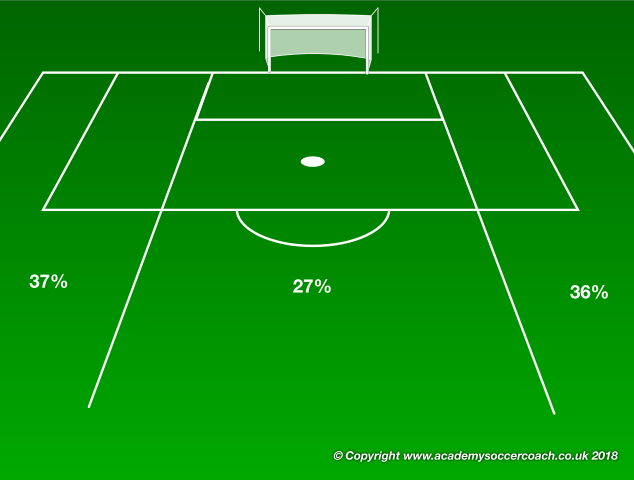
Where to coach the shots on goal? Again, following the 2017/2018 Premier League data, 7.65% of the moves were finished inside the 6 yards box, 52.6% inside the 18 yards box, and 39.8% outside the penalty area.
From a strictly coaching point of view, the 6 yard box is useful related to coaching attacks on the near post or recovering goalkeepers’ missed saves. The 18 yard box and the space around the penalty area are more important to coach finishing phases and players’ skill to shoot on goal.
